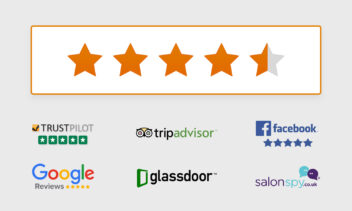How is the customer review landscape changing?
The simplistic rule of marketing has always been:
“If you can get other people to say nice things about you, it is far more powerful than saying nice things about yourself.”
But it’s not like Coca-Cola are about to say, “Actually, you know what? Coke sucks!” Of course, they are going to say good things about themselves, but consumers will only say good things about Coca-Cola and its products if they genuinely mean it.
This is the reason why consumer reviews have always been an important marketing tool and trust symbol for businesses.
Traditionally, review platforms such as Trustpilot and TripAdvisor have formed the basis of most businesses’ review strategies, but the old adage that ‘everyone’s a critic’ is true and technology has made it easier than ever for consumers to share their voice.
Google Reviews & Local SEO
As consumers, our first introduction to a brand or service is normally through trusty old Google. In fact, Google processes over 3.5 billion searches a day and the search engine’s constant evolution is built to give consumers everything they need at the click of a button before we even reach a company’s site. Importantly, this includes reviews both in the SERPs and Google My Business’ ‘Reviews From the Web’ feature! So essentially, we are hearing stories about and experiences of brands and companies before they have the chance to introduce themselves.
Yet the impact of Google reviews goes far beyond being a simple trust signal and has an important effect on positioning in local SEO. The SEO landscape has changed dramatically in recent years. Google rankings are no longer a simple list of 10 and marketers have to consider paid adverts and local packs along with a collection of new additions to typical SERPs. The local pack, in particular, is directly influenced by the presence of reviews, meaning the benefits of chasing these reviews is twofold.
Reviewing in a Social World
Where the review landscape has seen its most profound change though is in the world of social media. Social media platforms have given consumers a true, uncensored voice where they hold much of the power over their brands of choice. Facebook was quick to try and harness this power by introducing reviews on their pages. Facebook reviews have proven an effective tool and an important trust symbol that local businesses, in particular, should use.
However, businesses need to understand and respect the fact that all social platforms are already in their own right – review platforms. Twitter in particular, essentially acts as a huge stream of consciousness where users can and will share their every thought. This is why businesses should always look to use as many platforms as they can manage. Regardless of whether they are on a platform, a business can and will still be discussed, and it is far better for a brand to be involved in that discussion and have some level of control.
Pictures vs Words
One social platform that has seen some attention recently from a reviews standpoint is Instagram. A recent article in the Telegraph suggested that Instagram is superceding TripAdvisor as a source of restaurant reviews because “customers prefer looking at pictures to reading text”. There is definitely some truth in this, with users flocking to Instagram and using it as an inspirational tool. More and more accounts are being set up primarily to review products, restaurants and various services, and with such a visual focused approach, enticing images will always add some weight as a trust symbol.
A spokesperson for TripAdvisor disagreed, commenting: “Comparing Instagram to TripAdvisor is like comparing apples to oranges. Millennials aren’t using Instagram in the same way or for the same purpose as they use TripAdvisor, and often they are using both. When someone looking for a restaurant comes to TripAdvisor, they are typically at the point where they are ready to make a final decision on where to eat, and that’s because we offer a lot more tools that help millennials find the perfect restaurant than apps like Instagram.”
This assessment certainly has merit and TripAdvisor are correct to point out that they are different tools, but it’s hard to deny that Instagram, along with other popular social platforms are muscling in on the turf of review platforms like TripAdvisor and Trustpilot.
Should we be scared of reviews?
With such a multitude of ways for consumers to share their reviews, it’s understandable that the reviews landscape would be a daunting prospect for businesses. However, businesses shouldn’t shy away from it. As mentioned, if a consumer wants to share their experience of a brand or business (good or bad), then they will do so on the platform of their choosing. A bad review is obviously not a good thing, and no business wants to see unhappy customers, but the reviews offer an opportunity to display some real customer service and find the suitable resolution for the customer in question. If a customer feels unhappy or unloved after his or her first experience of your service, how you respond to the review can go a long way to changing their perception and decide how they interact with you in the future.
In reality, businesses that have confidence in their product or service should have no reason to shy away from reviews, and with consumer voices being so prominent, businesses should be looking to directly connect with their audiences.
If you would like to discuss your reviews strategy and how your business can integrate it into your marketing activity, get in touch with us today.


















